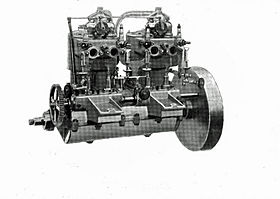Daimler Twenty-Two
| Daimler 22 hp | |
|---|---|

4½-litre 4-cylinder 1903
nascent flutes on the radiator's side tanks |
|
| Overview | |
| Type | car (also available as a chassis only) |
| Manufacturer | Daimler Motor Company |
| Production | July 1902 to December 1903 |
| Designer |
|
| Body and chassis | |
| Class | Full-size luxury car (F) |
| Layout | front engine, rear-wheel-drive |
| Related |
|
| Powertrain | |
| Engine |
|
| Transmission | leather-lined clutch, flexible jointed splined propellor shaft to 4-speed and reverse gearbox enclosed as a unit with differential and countershaft in an aluminium casting. final drive by sprockets and side chains. |
| Dimensions | |
| Wheelbase |
|
| Kerb weight | 2,500 lb (1,134 kg) bare chassis |
| Chronology | |
| Predecessor | 16/18 |
| Successor | 18/22 |
| Daimler 22 horsepower |
|
|---|---|

design for 4½ and 3.4-litre engines
|
|
| Overview | |
| Manufacturer | Daimler Motor Company |
| Combustion chamber | |
| Configuration | vertical inline 4-cylinder |
| Displacement | 4,503 cc (274.8 cu in) |
| Cylinder bore | 105 mm (4.1 in) |
| Piston stroke | 130 mm (5.1 in) |
| Cylinder block alloy | cast iron. twin-cylinder blocks installed in pairs |
| Cylinder head alloy | cast with cylinder block |
| Valvetrain |
|
| Combustion | |
| Fuel system |
|
| Fuel type | petrol |
| Oil system | piped pressurised by exhaust system |
| Cooling system | water, centrifugal pump, fan, radiator |
| Output | |
| Power output |
|
| Chronology | |
| Predecessor | 16/18 |
| Successor | 18/22 |
Their new Daimler 22 horsepower full-size luxury car was first displayed by Daimler in April 1902 at The Automobile Club’s Exhibition in London's Agricultural Hall. Daimler had elected to drop their multiple old low powered designs and restrict themselves to this 22 horsepower and a pair of 9 or 12 horsepower cars to the same design as the 22 but more lightly constructed. The King’s not quite finished new Daimler 22 was reported to be the chief attraction of the show.
The 22 horsepower cars were geared to run at about 40 to 50 miles per hour when the engine was running at normal speed.
The following January 1903 Daimler, having earlier dropped the 9 hp, replaced their 12 with a 14-horsepower car making a range of just two vehicles.
In January 1904 Daimler introduced a wholly new range of four cars including a 3.8-litre 18/22.
The 4½-litre 22, and its 3.4-litre stablemate the 12, were developed and their construction organised by Percy Martin then works manager. The twin-cylinder 9 hp car was soon dropped. Although they were first displayed in April deliveries did not begin until July and a steady production stream did not eventuate until November 1902. These new models were the product of the board's decision to end production of old type cars and restrict the range to two or three models with standardised interchangeable components. This new range was between 25 and 30 per cent lighter than their preceding equivalents and had much improved speed and hill-climbing power. All the wheels were now the same size. The redesigned steering helped to make them easier to drive. The lowered chassis frame increased the cars' stability and made entry easier. The more rigid chassis frame improved the alignment of the transmission system. Finally this new model cost 17 per cent less to manufacture than its predecessor.
Standard bodies were built in Daimler's own body department which would also provide bespoke bodies on different wheelbases to special order. Chassis were made available to customers' own coachbuilders. The same body was used on the 22 hp as on the 9 and 12 hp chassis.
The 4-cylinder, 4½-litre side-valve engine is a pair of cast iron twin-cylinder blocks bolted to an aluminium crankcase cast in upper and lower halves.
It develops 22 hp at 720 rpm at which speed in top gear the car should be running at between 40 and 50 mph.
The engine's governor regulates by suspending the action of the exhaust valves consecutively. There are also throttle valves under the control of the driver.
...
Wikipedia
